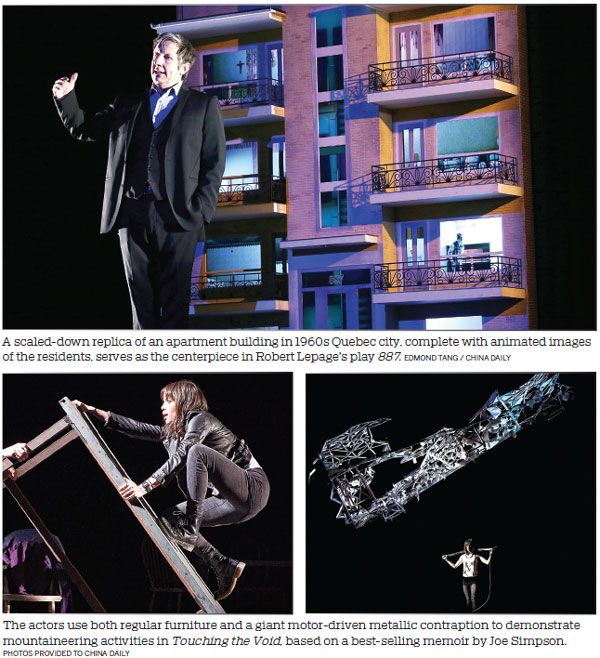Touching new heights
Updated: 2019-03-08 06:08
(HK Edition)
|
|||||||||
Both Touching the Void and 887 - staged as part of the ongoing Hong Kong Arts Festival - are remarkable feats of production design, says Cahitralekha Basu.
The Hong Kong Arts Festival lineup this year includes at least two shows that stand out for their remarkable production design. Both Touching the Void and 887 are flawlessly executed, edge-of-the-seat experiences, raising deep existential questions. And both pull off extraordinary feats of stage art by harnessing high-tech as well as very basic theatrical tools.
Touching the Void is adapted from the mountaineer Joe Simpson's best-selling memoir. In 1988, Simpson was taken for dead after he got caught in a snow storm on the Siula Grande mountain in the Peruvian Andes, suffered severe injuries and fell 150 feet. The play reimagines the incredible story of how Simpson walked for nearly three days without food, dragging a broken leg, and eventually made it to the base camp alive.
The scale of this true story seems too enormous to fit into a proscenium stage but Ti Green's production design has brought the scenes in David Grieg's script to life to spectacular effect. The ambitious, and potentially fragile, nature of attempting to represent Simpson's journey in art - not unlike trying to scale a snow-clad peak 20,814 feet above sea level as Simpson and his climbing partner Simon Yates had set out to do - is underscored when the character of Richard, a wannabe writer of mountaineering stories who lacks the motivation to scale the heights himself, creates a slapdash model of the trekkers' route. By piling wooden chairs on top of each other and placing randomly selected boards (including a Gents' sign) against a wall, Richard creates a ludicrous replica of the mighty mountains. And yet his handiwork seems totally respectable, as earlier in the play the actors had demonstrated that upright boards and slanting tables can not only represent cliffs and mountain slopes, but are also eminently climbable.
Touching the Void succeeds in stoking the audience's ability to imagine by skillfully manipulating their sense of perspective. An actor lying on a table with only the top of his head visible to the audience becomes instantly believable as a man dangling from a cliff on a never-ending abyss. Compared to such choreography, the giant shape-shifting metallic contraption in the background representing the mountains seems more of a technical achievement.
Doll's house with a twist
In 887, its creator, the Canadian auteur Robert Lepage, straddles several binaries - boyhood-maturity, emotion-rationale, French-English, memories-amnesia and so on. The play is a dramatization of moments from Lepage's life and concerns, told like a story, or perhaps a lecture with visuals.
The pairing of opposites is epitomized in the set design. The centerpiece is both a gigantic doll's house and a scaled-down replica of a four-storied apartment bloc - modeled after building No 887 on Murray Avenue, Quebec City, where Lepage lived as a boy in the 1960s. The visual detailing is painstakingly astute. Pint-sized residents appear on digital screens at their respective apartment windows, morphing into porcelain dolls when they step out onto the balcony. However, when turned inside out, building No 887 transforms into the interior of a condo (this time life-sized) in an upscale Quebec neighborhood with a glossy kitchen and well-stocked library - the home of a mature Lepage.
887 is an exemplar of the magic sophisticated technology can conjure up on stage even as it uses stage tools that are as old as theater itself. Live shadow puppetry happily co-exists with digitally animated shadow figures. The faces of tiny porcelain figures assembled in a miniature version of Quebec's Parc des Braves are magnified several times on screen via Lepage's phone. However, when trying to remember Michele Lalonde's 1968 poem Speak White - written in protest against the cultural impositions made on Francophone Quebecers by the English-speaking dominant social classes - Lepage looks for a mnemonic formula rather than assistance from computer-aided technology.
Size is a major theme in 887 but it's also shown as relative. The cars used in the play range from microscopic - visible only through a magnified on-screen image - to gigantic, the result of an optical illusion, engineered through clever lighting. Kudos to creative director and designer Steve Blanchet for creating a pulsating and spectacular world out of Lepage's vision.

(HK Edition 03/08/2019 page11)